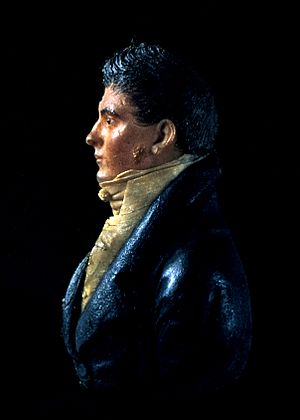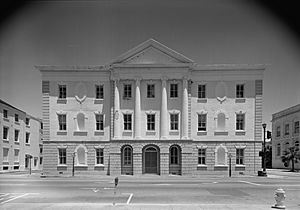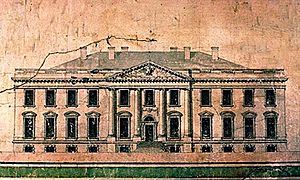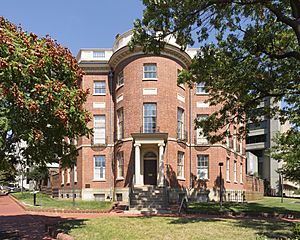James Hoban facts for kids
Quick facts for kids
James Hoban
|
|
|---|---|

|
|
| Born | 1755 Callan, County Kilkenny, Ireland
|
| Died | December 8, 1831 (aged 75–76) Washington, D.C., U.S.
|
| Alma mater | Royal Dublin Society School of Drawing in Architecture (later the National College of Art and Design) |
| Occupation | Architect |
| Spouse(s) | Susanna Sewall |
| Children | James Hoban Jr. |
| Buildings | The White House Belcamp House Charleston County Courthouse Rossenarra House |
James Hoban (1755 – December 8, 1831) was an Irish-American architect. He is most famous for designing the White House, the official home of the U.S. President.
Contents
Early Life and Learning


James Hoban grew up in County Kilkenny, Ireland. He worked as a wheelwright and carpenter. In 1779, he began studying drawing at the Royal Dublin Society's school. He was a very good student. In 1780, he won a special medal for his drawing skills. Hoban learned from a famous architect named Thomas Ivory. He stayed with Ivory until he moved to America around 1785.
Hoban arrived in South Carolina by 1787. There, he designed many buildings. One important building was the Charleston County Courthouse. It was built between 1790 and 1792. This building caught the attention of George Washington, who was the first U.S. President.
Designing Famous Buildings
After the American Revolutionary War, Hoban moved to the United States. He started his architecture business in Philadelphia in 1785. President George Washington was very impressed with Hoban's work. Washington met Hoban in Charleston, South Carolina in 1791. He then asked Hoban to come to Philadelphia, which was the nation's capital at the time.
In 1792, Hoban won a competition to design the White House. His first idea looked similar to the Charleston Courthouse. It had three stories. President Washington suggested changes to the design. Hoban changed it to a two-story building. Washington also insisted that the entire mansion be built with stone.
During the construction of the White House, some enslaved people worked as carpenters. Their names were Ben, Daniel, and Peter. They were listed on Hoban's payroll.
Hoban also helped supervise the building of the United States Capitol. This building was designed by another architect, William Thornton. Hoban also oversaw the design of The Octagon House. He lived the rest of his life in Washington, D.C.. He continued to work on public buildings, roads, and bridges.
Hoban was also a member of the Freemasons. He is also thought to have designed Rossenarra House in Ireland in 1824.
Later Life and Legacy
Hoban was involved in the local government of Washington, D.C. He served on the city council for many years. He also helped develop Catholic institutions in the city. These included Georgetown University and St. Patrick's Parish. His son was a member of the Jesuit community at Georgetown.
Hoban's wife was Susanna Sewall. Her brother, Clement Sewall, was a well-known person in Georgetown. He fought in the American Revolutionary War.
Death
James Hoban passed away in Washington, D.C., on December 8, 1831. He was first buried at Holmead's Burying Ground. Later, his body was moved to Mount Olivet Cemetery. His son, James Hoban Jr., later became a U.S. attorney.
Notable Architectural Works
Hoban designed many important buildings. Here are some of his most famous works:
- Charleston County Courthouse, Charleston, South Carolina (1790–1792). This building and the White House were inspired by Leinster House in Ireland.
- The White House, Washington, D.C. (1792–1800). After the White House was burned in 1814, Hoban helped rebuild it. He added the Southern Portico in 1824 and the Northern Portico in 1829.
- The Octagon House, Washington, D.C. (1802).
Other Buildings Attributed to Hoban
Some other buildings are believed to have been designed by Hoban:
- Prospect Hill, Edisto Island, South Carolina (around 1790).
- First Bank of the United States, Philadelphia (1795).
- McCleery House, Georgetown, Washington, D.C. (around 1800).
- The William John Edward House, Edisto Island, South Carolina (1810).
- Baum-Taft House (now the Taft Museum of Art), Cincinnati, Ohio (1820).
- Oak Hill, the home of President James Monroe, Aldie, Virginia (1820).
- Rossenarra House near Kilmaganny, Ireland (1824).
- Belcamp House at Belcamp College, Dublin.
Buildings That No Longer Exist
Some buildings Hoban designed have been torn down or destroyed:
- Blodget's Union Public Hotel, Washington, D.C. (1783).
- Wye Hall, Maryland (around 1787).
- South Carolina State House, Columbia, South Carolina (1790). This building burned down in 1865.
- The Charleston Theatre, Charleston, South Carolina (1792).
- Northeast Executive Building, Washington, D.C.
- Market House, Washington, D.C. (1801).
- St. Patrick's Church, Washington, D.C.
- St Mary's Chapel, Washington, D.C. (1806).
Remembering James Hoban
Around 2008, many events celebrated the 250th anniversary of Hoban's birth. A special memorial was built near his birthplace in 2008. A big exhibit about his life was also held at the White House Visitor Center. A musical group called Solas has a song that honors Hoban. One of the band members is from Kilkenny, just like Hoban.
See also
- John Henry Devereux South Carolina architect
- List of people on stamps of Ireland
- White House
- Pedro Casanave




